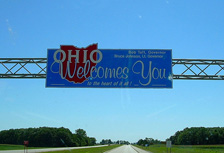Drug Addiction in Ohio
Drug Abuse Replaces Rust Belt Economy
 Employment in Ohio has been in a rut for several decades now, with manufacturing and industry being shipped little by little to other countries. Now, much of the economy in urban Ohio has been replaced by drug trafficking imported from Latin America. Drug cartels operate freely in the urban areas of Cleveland, Columbus, Cincinatti as well as many other areas. The rise of crystal methamphetamine and prescription drug abuse in the 2000's has hit many parts of Ohio very hard. Admission and treatment for alcohol, cocaine, and heroin have all been steadily rising across the state.
Employment in Ohio has been in a rut for several decades now, with manufacturing and industry being shipped little by little to other countries. Now, much of the economy in urban Ohio has been replaced by drug trafficking imported from Latin America. Drug cartels operate freely in the urban areas of Cleveland, Columbus, Cincinatti as well as many other areas. The rise of crystal methamphetamine and prescription drug abuse in the 2000's has hit many parts of Ohio very hard. Admission and treatment for alcohol, cocaine, and heroin have all been steadily rising across the state.
Unfortunately part of Ohio's drug crime problem is that of ineffective enforcement. Ohio's pentitentiary system takes in around 25,000 new inmates every year, and yet today in cities such as Youngstown over 50% of drug related arrests are for possession. Very little is done to stem the tide of drugs into a part of the country that is not known for producing its own, and the small fraction of drug arrests that are for major drug trafficking and financing of drug operations shows that despite the billions spent, people that are in need of addiction treatment are instead constantly able to find cheap, dangerous highs, with non-rehabilitative jail as a second option. Incarceration is rarely an effective way to treat drug addiction; mental health and drug problems fester in as much as 50% of America's prison population and addiction treatment and curbing of prison contraband has been historically inadequate in our prison system.
Urban, De-industrialized Cities Now Havens of Drug Crime and Abuse
Cincinatti is one of the largest urban centers in the state, and ever since the early 2000's has seen a quickly rising crime rate centered around impoverished communities of color. Many people cite the large-scale riots of 2001 centering around police shootings of young black men culminating in the death of 19 year old Timothy Thomas. After these riots the homicide rate in the city went from 40% to 88% and has not declined in over ten years. Much of the continued violence in Cincinatti is attributed to its large drug gang problem.
However, Cleveland is well and above the worst-hit area in Ohio by drug problems. Cleveland generally ranks within the top 10 most dangerous cities in the country. Despite years of growing problems, 2012 is already on track to be one of the most violent on record in Cleveland. Historically Chicago criminal enterprises have used Cleveland as a hub for its operations and Latin American gang families are no exception. At least 150 gangs operate in the greater Cleveland area, much of whom have ties with Chicago's drug traffickers.
Unfortunately, the availability of addicted and pervasive drugs are always a difficult, international problem that nobody has ever been able to safely and effectively curtail. However, localities all around the world have shown that even places such as Cleveland can be reformed from the inside out with a sound approach to drug abuse rehabilitation. When people are educated and aware of the benefits of different types of addiction recovery than great strides can be taken to engage in it. These suffering people need to understand that in the case of chronic cases of abuse that trying to find the will to quit and depending on family and friends is often not enough. Alcohol, cocaine, heroin, prescription opiates and depressants, and many other drugs create a chemical relationship with a person's brain that often makes it impossible to resist the craving to get high again.
In these cases addiction treatment is the only solution to safely detox someone and re-create the will to live a sober life in these situations. Supervised detox inside a safe and healing environment is often only the beginning. Months of addiction treatment therapies will follow where the patient will not just re-acclimate to clean living but will need to develop the courage and self-esteem necessary to fight off any future physically or psychologically enduced cravings. Relapse is always a constant danger that too many in recovery fall for, and drug rehab programs are what works best to create strong wills to resist future temptations.
Ohio cities with the most severe drug abuse problems: Cleveland, Cincinnati, Columbus, Dayton, Toledo, Akron, Youngstown, Canton, Hamilton, and Springfield.
Counties with the largest concentrations of drug abuse problems: Cuyahoga, Franklin, Hamilton, Montgomery, Summit, Lucas, Stark, Butler, and Lorain counties.
A Center for Addiction Recovery treats the following addiction problems:
- Alcohol Rehab
- Bath Salts Rehab
- Drug Rehab
- Cocaine Rehab
- Heroin Rehab
- Marijuana Rehab
- Meth Rehab
- Prescription Drug Rehab
- Pain Management
- ADD Treatment
- Bipolar Disorder Treatment
- Cutting Addiction Treatment
- Depression Treatment
- Eating Disorders Treatment
- Gambling Addiction Treatment
- Mood Disorders Treatment
- Post-Traumatic Stress Disorder
- Sex Addiction Treatment
- Withdrawal
A Center for Addiction Recovery offers the following addiction treatment programs:
- Intervention
- Detox
- Drug Addiction Treatment
- Alcohol Addiction Treatment
- 12 Step Program
- Dual Diagnosis Treatment
- Drug Rehab for Women
- Residential Addiction Treatment
- Executive Addiction Treatment
- Addiction Treatment Aftercare






